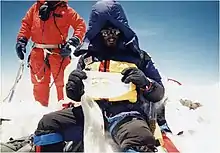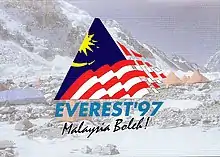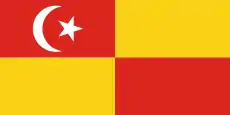M. Magendran
Datuk M. Magendran PJN DSPN JSM KMN AMS (Tamil: எம். மகேந்திரன்) born Magendran M. Munisamy[9] on 6 December 1963[5] in Kuala Lumpur, Malaysia) is the first Malaysian mountain climber to conquer the summit of Mount Everest.[10][11] Magendran's party ascended the South Col on the southeast ridge.[9] He stepped onto Everest's summit on 23 May 1997, at 11:55 a.m. local time. He was followed by N. Mohanadas (Mohanadas Nagappan), who reached the summit a few minutes later at 12:10 p.m.[12][13] The two mountaineers were part of the first "Malaysia-Everest Project 97" jointly organised by the Malaysia Mountaineering Association and the Ministry of Youth and Sports of Malaysia. Also with their team of ten people was M. Moorthy (Moorthy Maniam), a Malaysian of Indian descent.
Datuk M. Magendran | |
|---|---|
எம். மகேந்திரன் | |
 M. Magendran on the summit of Mount Everest - 23 May 1997 | |
| Born | Magendran M. Munisamy 6 December 1963 (age 57) |
| Nationality |
|
| Education | M. Ed,[1] University of Malaya, Kuala Lumpur, Malaysia. B. Sp. Sc (Hons), University of Malaya, Kuala Lumpur, Malaysia. |
| Occupation | Teacher / Sports Manager[2][3] |
| Known for | |
| Spouse(s) | Datin V. Senthamarai[7] |
| Children | 3[8] |
Mount Everest is the world's highest mountain, with a peak at 8,848 metres (29,029 ft) above sea level. Its summit was first achieved in 1953 after numerous failed attempts that began in 1921. The first person to finally set foot on its summit was New Zealander Sir Edmund Hillary, who was accompanied by Tenzing Norgay of India. Both M. Magendran and N. Mohanadas were conferred Datukships by the Penang state government in 2010 for their Himalayan achievement.[14][15] Both men were also conferred the Federal 'Datukships' title by the King of Malaysia in Jun 2011
In June 2013, Datuk Magendran, who is considered a pioneer among Malaysians, gave advice for those mountain climbers who would brave the hazards of the world's highest peak:
ALL safety and preparatory efforts must be taken before setting out on a mountain climb, especially when it involves the world's tallest mountain. One should be very well prepared and must have undergone rigorous physical and mental training before taking on the mammoth peak, [...] One must undergo sufficient training and preparation, which includes endurance training and altitude training. I had been involved in outdoor activities such as mountain climbing and jungle-trekking for ten years and received almost three years of rigorous training before our team left for Mount Everest in 1997.[16]
Magendran urged future climbers and trekkers not to overlook their health before and during the climb, adding that any symptom that was overlooked could be fatal. He also reminded, "Trekkers should keep an eye on the health of their teammates, too."[16]
The year 1997 also commemorated the 40th anniversary of Malaysian independence.[17] In 2000, both M. Magendran and N. Mohanadas were pictured on their nation's postage stamps.[4]
Magendran is a vice-principal in SMK USJ 8, in Subang Jaya. Being a Sports Science and Physical Education graduate, he also teaches Physical Education.[18]
`Malaysia Boleh!’ (Malaysia Can Do It!)

The idea of `Malaysia Boleh!’ was first mooted in 1993 by Nestle and made its debut as part of a marketing campaign for Milo (drink), and a confidence boost for the Malaysian contingent during the 1993 Southeast Asia Games in Singapore.[19] The`Malaysia Boleh!’ slogan slowly gained influence as a signature battle cry in the mid 1990s when Prime Minister Mahathir Mohamad co-opted the catch phrase to spur the nation's Vision 2020. Likewise, the Malaysia-Everest `97 organizing committee also incorporated the phrase to its official expedition logo to instill a sense of confidence and perseverance among the climbers. And the force of the slogan worked both ways, it gave the climbers the competitive spirit to strive for excellence and the success of the expedition gave the much needed oomph to the `Malaysia Boleh! spirit.[20] The slogan became more popular and inspired many Malaysians to embark on other adventures like the Read brothers who walked to the last degree of the North pole (1998), Dato' Azhar Mansor who sailed solo around the world (1999), Dato' Abdul Malik Mydin who swam across the English Channel (2003) and many more.[21][22] The stories of these exemplary Malaysians never cease to amaze the Prime Minister whenever he speaks about discipline, patience and over-coming challenges.[23] Tun Dr. Mahathir Mohamad in his book, A Doctor in the House: The Memoirs of Tun Dr. Mahathir Mohamad (pg. 589) stated that:
The new `Malaysia Boleh!’ (Malaysia can do it) seemed to take hold and coincide with the period of growth. The Malaysia Book of Records had also been started and people now try to pull off unusual feat to get into it. The new competitive spirit, combined with the desire to show that Malaysians could do anything, generated much excitement in the country. Datuk Azhar Mansor sailed solo around the world; Datuk M. Magendran and Datuk N. Mohanadas climbed Mount Everest; Datuk Abdul Malik Mydin swam across the English Channel [...] People cheered these plucky Malaysians and saw their achievements as, if not world-beating, at least world-class.[24]
Awards and recognition
- On 29 May 2003, M. Magendran and N. Mohanadas (the only two Mount Everest summiteers from Malaysia) received the Mount Everest Golden jubilee Medals from the Honourable Prime Minister of Nepal, Lokendra Bahadur Chand. Both were invited by the Nepal Mountaineering Association (NMA) to be a part of the week-long celebration organized by the Nepal Government in conjunction with the 50th Anniversary of the conquest of Mount Everest in 1953.[25][26]
- On 10 July 2010, M. Magendran was among 47 people who were conferred the Darjah Setia Pangkuan Negeri award (DSPN),[27] which carries the title Datuk in conjunction with the 72nd birthday of the Penang State Governor Tun Abdul Rahman Abbas.[28] Magendran was honoured along with team mate N. Mohanadas.[29] Second Deputy Chief Minister of Penang Prof. Dr. Ramasamy Palanisamy[27] said the state government gave the awards to the duo to recognize their feat.
- On 4 June 2011, M. Magendran was honoured with the Distinguished Order of Meritorious Service (Darjah Panglima Jasa Negara) or PJN[30] in conjunction with the birthday of His Majesty Tuanku Mizan Zainal Abidin,[31] the 13th King of Malaysia. Magendran was among 67 people who were conferred the PJN award which carries the tilte Datuk.
- On 23 May 2017, Both M. Magendran and N. Mohanadas together with other team members of Malaysia-Everest 97 expedition were honoured in an event “Two decades of first Malaysians on Everest” organised by The Malaysian Indian Sports and Cultural Foundation (MISCF)[32] and Ministry of Youth and Sports (Malaysia) to commemorate the 20th anniversary of their historic feat.[33][34][35]
Honours
.jpg.webp)
Honours of Malaysia
 Malaysia :
Malaysia :
 Commander of the Order of Meritorious Service (PJN) - Datuk(2011)[36]
Commander of the Order of Meritorious Service (PJN) - Datuk(2011)[36] Companion of the Order of Loyalty to the Crown of Malaysia (JSM) (2004)[37]
Companion of the Order of Loyalty to the Crown of Malaysia (JSM) (2004)[37]_-_SMN.svg.png.webp) Officer of the Order of the Defender of the Realm (KMN) (1997)[37]
Officer of the Order of the Defender of the Realm (KMN) (1997)[37]
.svg.png.webp) Penang :
Penang :
 Officer of the Order of the Defender of State (DSPN) - Datuk (2010)[38]
Officer of the Order of the Defender of State (DSPN) - Datuk (2010)[38]
 Selangor :
Selangor :
 Member of the Order of the Crown of Selangor (AMS) (1999)
Member of the Order of the Crown of Selangor (AMS) (1999)
See also
References
- "University of Malaya Theses and Dissertations".
- "German stint for Rayzam and Hup Wei". The Star. 18 April 2013. Retrieved 6 August 2019.
- Aftar Singh (27 February 2015). "High jumper Hup Wei might miss SEA Games again". The Star Online. Retrieved 6 August 2019.
- Malaysia at Random. At Random Series. Editions Didier Millet. 2010. p. 75. ISBN 978-9814217958. Retrieved 20 July 2013.
- "Datuk M Magendran - The first Malaysian Mount Everest summiteer".
- "Siri Milenium III - Semangat Malaysia Baru". Retrieved 6 August 2019.
- Manjit Kaur (11 July 2010). "On top of the world again - Mt. Everest climbers happy to get recognition for their feat". The Star. Retrieved 6 August 2019.
- Frankie D'Cruz (25 May 2020). "For Malaysia's Everest conquerors - no dream is too high". FMT. Retrieved 25 May 2020.
- Reinhold Messner (1999). Everest: Expedition to the Ultimate. The Mountaineers Books. p. 256. ISBN 0-89886-648-0. Retrieved 20 July 2013.
- "Malaysia's Everest Quest". 1 September 1997. Archived from the original on 23 September 2013. Retrieved 19 July 2013.
- Khalid Yunus. "Mountaineering". The Encyclopedia of Malaysia. encyclopedia.com. Archived from the original on 17 June 2012. Retrieved 19 July 2013.
- The Malaysia Book of Records (1995–2012). "The Best Records of the Year". Malaysiarecords.com.my. Archived from the original on 20 October 2013. Retrieved 19 July 2013.
- Sambutan Kemerdekaan (1997). "Mount Everest Expedition". Malaysiamerdeka.gov.my. Archived from the original on 18 May 2013. Retrieved 19 July 2013.
- K. Suthakar (10 July 2010). "Mt Everest climbers get Datukships". The Star Online. Archived from the original on 20 October 2013. Retrieved 19 July 2013.
- "Two ethnic Indians receive Malaysia's Datukship title". The Indian Express. 12 July 2010. Retrieved 19 July 2013.
- Kalbana Perimbanayagam and Hashini Kavishtri Kannan (11 June 2013). "Safety key to Everest ascent". New Straits Times Online. Archived from the original on 16 June 2013. Retrieved 17 July 2013.
- The UK Statute Law Database: Federation of Malaya Independence Act 1957 (c. 60). Retrieved 19 July 2013
- Shahanaaz Habib (4 June 2017). "Still feeling on top of the world". The Star Online. Archived from the original on 18 October 2017. Retrieved 3 June 2018.
- Samantha Khor. "Did you know:The iconic 'Malaysia Boleh!' Slogan originated from a marketing campaign". Retrieved 13 June 2019.
- Frankie D'Cruz (25 May 2020). "For Malaysia's Everest conquerors - no dream is too high". FMT. Retrieved 25 May 2020.
- Maf73 (6 April 2011). "Malaysia Boleh". The Star. Retrieved 12 June 2019.
- "M. Magendran- The first Malaysian Mount Everest Summiteer".
- "PM:Discipline and patience are also vital". The Star. 31 August 2003. Retrieved 23 June 2019.
- Mohamad, Mahathir (2011). A doctor in the house: The momoirs of Tun Dr Mahathir Mohamad (3rd ed.). Selangor: MPH Group. p. 843. ISBN 978-967-5997-22-8.
- Laurinda Keys (30 May 2003). "Nepal marks 50th Anniversary of Mount Everest climb". Deseret News. Retrieved 12 June 2019.
- "Everest golden jubilee celebrations kick off". ABC News. 25 May 2003. Retrieved 12 June 2019.
- Manjit Kaur (11 July 2010). "On top of the world again - Mt. Everest climbers happy to get recognition for their feat". The Star. Retrieved 6 June 2019.
- K.Suthakar (11 July 2010). "Mt Everest climbers get Datukships". The Star. Retrieved 6 June 2019.
- Shahanaaz Habib (4 June 2017). "A mountain of memories". The Star. Retrieved 10 June 2019.
- "Abdullah Ayub among 1707 conferred titles in conjunction with king's birthday". The Star. 5 June 2011. Retrieved 11 June 2019.
- "List of award recipients in conjunction with king's birthday". The Star. 4 June 2011. Retrieved 11 June 2019.
- Y.P. Sivam (25 July 2014). "A boost for Malaysian Indian Athletes". The Star. Retrieved 10 June 2019.
- Y.P. Sivam (30 May 2017). "Mt Everest conquerors 20 years on". The Star. Retrieved 10 June 2019.
- R. Umavathi (24 May 2017). "Genap 20 tahun tawan Everest". Utusan Malaysia. Retrieved 10 June 2019.
- Nizha Periaswamy (25 May 2017). "Genab 20 tahun Magendran, Mohandas tawan Everest". FMT. Retrieved 25 May 2020.
- "Yang Di-Pertuan Agong's Birthday Honours List". The Star. 8 June 2011. Retrieved 6 June 2019.
- "Semakan Penerima Darjah Kebesaran, Bintang dan Pingat". Retrieved 6 June 2019.
- Manjit Kaur (11 July 2010). "On top of the world again - Mt. Everest climbers happy to get recognition for their feat". The Star. Retrieved 6 June 2019.
- Rahman, Abdul Aziz (2012). 100 Wira Negara (First ed.). Kuala Lumpur: Majlis Bekas Wakil Rakyat Malaysia (MUBARAK). p. 301. ISBN 978-967-10541-0-9.
- Ahmad, Norlaila (2008). Memori Pejuang Bangsa: Bersama mencipta masa depan gemilang (First ed.). Kuala Lumpur: Jabatan Penerangan Malaysia. p. 399. ISBN 978-983--5405-32-7.
- Mohamad, Mahathir (2011). A doctor in the house: The momoirs of Tun Dr Mahathir Mohamad (3rd ed.). Selangor: MPH Group. p. 843. ISBN 978-967-5997-22-8.
